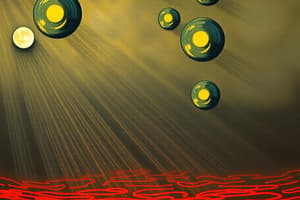Podcast
Questions and Answers
What is the primary way in which the Earth receives energy from the Sun?
What is the primary way in which the Earth receives energy from the Sun?
- Convection
- Transmission
- Conduction
- Radiation (correct)
Which type of energy is described as energy in reserve or stored?
Which type of energy is described as energy in reserve or stored?
- Kinetic energy
- Thermal energy
- Potential energy (correct)
- Mechanical energy
What is the wavelength range for shortwave radiation?
What is the wavelength range for shortwave radiation?
- Longer than 4 µm
- Shorter than 4 µm (correct)
- Exactly 4 µm
- Between 4 µm and 10 µm
Which of the following mechanisms is most effective for energy transfer through solids?
Which of the following mechanisms is most effective for energy transfer through solids?
How long does it take for radiation from the Sun to reach the Earth?
How long does it take for radiation from the Sun to reach the Earth?
What type of radiation is emitted by the Earth and atmosphere system?
What type of radiation is emitted by the Earth and atmosphere system?
What property must a hypothetical perfect emitter of radiation possess, defined by the term blackbody?
What property must a hypothetical perfect emitter of radiation possess, defined by the term blackbody?
Which type of energy transfer occurs through mixing in fluids, such as in boiling water?
Which type of energy transfer occurs through mixing in fluids, such as in boiling water?
What does the Stefan-Boltzmann Law explain about the relationship between temperature and emitted radiation energy?
What does the Stefan-Boltzmann Law explain about the relationship between temperature and emitted radiation energy?
According to Wien’s Law, what happens to the peak wavelength of emission as temperature increases?
According to Wien’s Law, what happens to the peak wavelength of emission as temperature increases?
What is the solar constant value, which represents energy received per unit area at the mean distance from the Sun?
What is the solar constant value, which represents energy received per unit area at the mean distance from the Sun?
What is the primary cause of the seasons on Earth?
What is the primary cause of the seasons on Earth?
During which event does each location on Earth experience equal day and night?
During which event does each location on Earth experience equal day and night?
What is the effect of solar angle on the amount of solar radiation received on Earth?
What is the effect of solar angle on the amount of solar radiation received on Earth?
What is perihelion in relation to Earth's orbit around the Sun?
What is perihelion in relation to Earth's orbit around the Sun?
What occurs during the December Solstice?
What occurs during the December Solstice?
Study Notes
Energy Types and Definitions
- Energy is defined as the ability to perform work.
- Kinetic energy refers to energy in motion.
- Potential energy is stored energy, based on an object’s position.
Energy Transfer Mechanisms
-
Conduction: Transfer of heat between solids through direct contact.
- Heat moves molecule-to-molecule without physical movement of the substance.
- Example: Heat transferring into the ground.
-
Convection: Transfer of heat in fluids (liquids and gases) via mixing.
- Boiling water demonstrates convection currents.
- Natural examples include winds and rising warm air.
-
Radiation: Energy transfer without a medium; can occur through a vacuum.
- Solar radiation is the primary source of energy from the Sun.
- Different types of radiation vary by wavelength.
Solar Radiation
- Known as Insolation; Earth's only method to receive solar energy.
- Takes approximately 8 minutes and 20 seconds for solar radiation to reach Earth.
Types of Radiation
-
Shortwave Radiation:
- Wavelengths shorter than 4 µm.
- Example: Solar radiation.
-
Longwave Radiation:
- Wavelengths longer than 4 µm.
- Example: Radiation emitted by the Earth and atmosphere.
Blackbodies and Radiation Laws
-
Blackbodies are hypothetical perfect emitters with emissivity (e) of 1, absorbing all possible radiation.
-
Stefan-Boltzmann Law:
- The radiation energy emitted is proportional to the fourth power of the temperature.
- Formula: F = σT^4, where σ = 5.67 x 10^-8 W m^-2 K^-4.
-
Wien's Law:
- The peak wavelength of emission is inversely related to temperature.
- Formula: λ = a/T, with a constant of 2900 m·K.
-
Solar Constant:
- Measures solar energy's arrival rate at the Earth's atmosphere.
- Value: 1367 W/m².
Earth's Relationship with the Sun
- The ecliptic plane is the imaginary surface of Earth's orbit around the Sun.
- Perihelion: Earth's closest point to the Sun at 147 million km.
- Aphelion: Earth's farthest point from the Sun at 152 million km.
Earth's Rotation and Seasons
-
Earth rotates once every 24 hours, resulting in day and night.
-
The rotational axis is tilted at 23.5°, contributing to seasonal changes.
-
Seasons change due to axial tilt and Earth's orbital orientation toward the Sun.
Solstices and Equinoxes
-
June Solstice: Longest day of the year when the Sun reaches its northernmost point.
-
December Solstice: Shortest day of the year when the Sun reaches its southernmost point.
-
Equinoxes: Occur on March 21 and September 21.
- Both hemispheres experience 12 hours of daylight and darkness.
- Equal solar energy received in both hemispheres.
Factors Affecting Solar Energy Reception on Earth
- Period of Daylight: Determined by Earth's axial tilt.
- Solar Angle: Influences beam spreading; higher angles reduce spreading, leading to greater heating.
- Beam Depletion: Refers to the reduction of solar energy intensity as sunlight passes through the atmosphere.
Studying That Suits You
Use AI to generate personalized quizzes and flashcards to suit your learning preferences.
Description
This quiz explores various types of energy, including kinetic and potential energy, as well as the mechanisms of energy transfer: conduction, convection, and radiation. Understand how energy is defined and the processes through which it moves in different states of matter. Test your knowledge on solar radiation and its significance.




